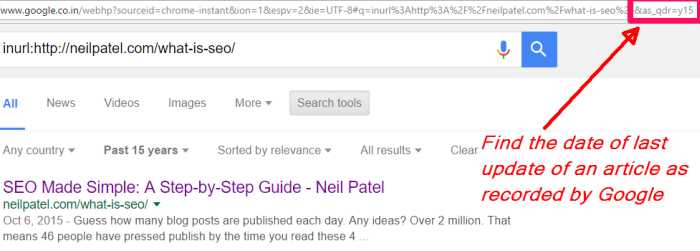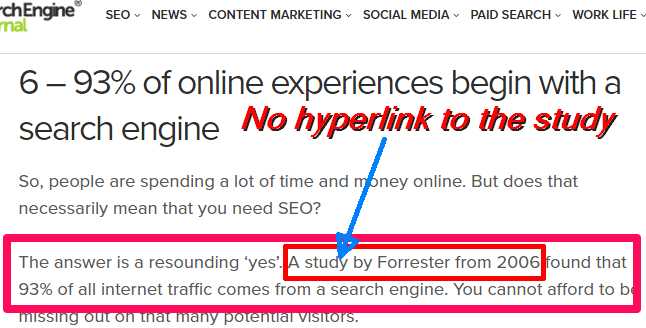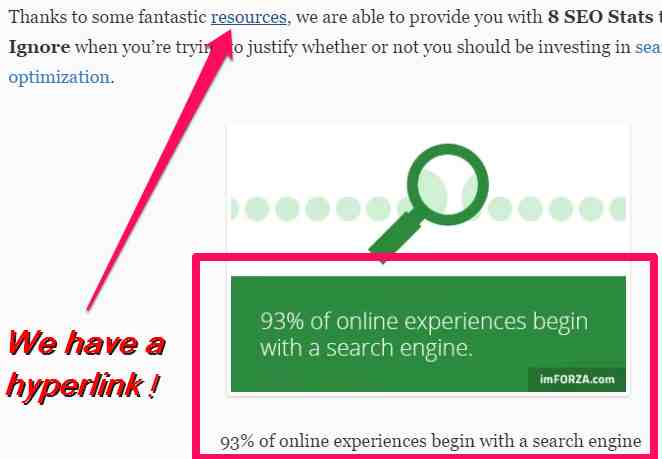Are You Sure You’re Citing Credible Statistics in Your Blog Posts?
Categories Content Quality, SEO Content Writing
There’s a whole lot of ‘credible statistics’ around the Internet. Make a search for statistics, especially in the context of SEO, and you are bound to come up with bucket-loads of crap that are frequently taken at face value.
And then there are sites and authors you’d normally trust. They provide value all the time and no one would blame you if you did take them at face value. No one would blame them, either, for the occasional slip – I know I wouldn’t.
And frequently, we find it convenient to mention statistics based upon what we find in such ‘authority’ articles and cite them as a source. You could cut a sorry figure if you did that without thinking.
This post is a natural sequel to my previous post on misleading statistics on authority sites. Hopefully, after reading this through, you’ll know what credible sources really mean.
But let’s get a popular myth out of the way, first.
Wikipedia is not a credible source of information
Now, that statement, by itself, is not a myth. However, the most popular reason cited for Wikipedia’s lack of credibility is. And that happens to be, ‘because anyone can edit Wikipedia content‘.
Most likely, this misguided view has its origin in what Wikipedia declares in a very specific context:
Wikipedia is not considered a credible source. Wikipedia is increasingly used by people in the academic community…However, citation of Wikipedia in research papers may be considered unacceptable, because Wikipedia is not considered a credible or authoritative source...This is especially true considering anyone can edit the information given at any time… (Source)
The context is academic research where ‘anyone can edit’ definitely becomes an important consideration when looking for credible sources. But that is a subject for another time and another place.
Our particular concern is to find and cite credible sources (especially of statistics) for blog posts and web content.
Regarding edits on Wikipedia, please note the following:
Wikipedia has robust version and reversion controls. This means that poor-quality edits or vandalism can quickly and easily be reversed or brought up to an appropriate standard by any other editor, so inexperienced editors cannot accidentally do permanent harm if they make a mistake in their editing. As there are many more editors intent on improving articles than not, error-ridden articles are usually corrected promptly. (Source)
There have been misleading edits (appropriately termed ‘vandalism’ where intentionally done) that have evaded discovery for quite a while.
But the notion that just because Wiki content can be edited by random persons, such content must lack authority, is unfounded. It isn’t exactly an open area where you can waltz in and insert your two cents without anyone noticing.
Go ahead and try to edit something, you’ll find out. Better still, sign up as a contributor and read the guidelines.
That said, Wikipedia is, indeed, not a credible source
It wouldn’t be, even if no one but verified Wikipedia staff could edit or create Wiki content.
Wikipedia is not a credible source because most (if not all) of the content is based on sources from elsewhere.
Come again?
Wikipedia, for example, does not create the statistics related to the State of California. It cites sources that are credible so that you get an article on California that is authoritative. The sources that it cites are the ones that created the stats through research or survey and published it. They are The Source. Wikipedia isn’t.
Therefore, when you are writing an article on California and want an authentic source to base your write-up on, feel free to conduct your research on Wikipedia, but don’t link to its content. Link, instead, to the sources cited in the specific article(s) you are consulting. And, always verify if the sources do, in fact, check out.
In other words, if you are going to cite, you must refer to the primary source. A website or company or even an individual that is an authority on a given subject may be the primary source if they have published their own findings after research.
Repeat: The primary source is The Source.
Note:
If a substantial part of your research is conducted by first reading Wikipedia and then following the links that it provides as sources, you should, ethically, mention that in your citation: Source X via Wikipedia.
Some clarification, beforehand
In the earlier article, I did not get personal, did not disclose the exact URL or the name of the author. Here, however, I am going to openly refer to everything, beginning with Neil Patel. The reason being, Neil Patel is an authority – no question on that. I have learned much from his articles, and this one little slip does in no way besmirch his reputation. He may not have bothered with exact sources because, the article, What is SEO, provides enough value to outweigh the occasional oversight.
I am not taking names to malign them. I am taking actual names (that are rightfully trusted) to drive home the point that there is no reason to blindly trust authority sites or individuals, or articles that provide superior value. Always dig deeper if you’re going to make your article an authority piece.
Take a look at how this trail goes:

Check out the number of Facebook shares. At least 1885 people decided the article was worth a share (and it is, make no mistake about that – you should definitely read it). And along with the article, the stats were also shared and believed in, I suppose.
Finding the date of publication
If you’re going to determine the relevance or authority of an article, you need to know when it was published. Unfortunately, there was no publication date mentioned, and neither did the URL disclose anything.
In such cases, it helps to look at the comments. The earliest one is dated October 2015. But I needed to know the date when the author had last updated the article (and, by inference, the stats).
A Google search with “inurl:ArticleURL” is the first step, and “inurl:http://neilpatel.com/what-is-seo/” brings up a result. Now append “&as_qdr=y15” to the end of the URL in the address bar of the result Google is displaying and press Enter. Now we have the date of the last update as noted by Google
.
Looks like it was published / last updated on October 6, 2015 – look at the beginning of the meta description right below the URL in green (neilpatel.com/what-is-seo/).
Here’s a source that will show you ways to find the publication / last update date of web content where none is mentioned.
Next Step
Clicking the link takes me to the alleged source – which refers to yet another source but does not link to it.

This is an article which dates back to November 21, 2011, on Search Engine Journal, another authority site.
So, what we have is an article from late 2015 citing an article written in late 2011 citing an unverified source published in 2006.
How credible is that?
If you think that’s bad…
Take a look at this one.
Let’s find out the date of publication of this next article that cites sources for the same “93% ” stats. Using the same method as earlier, we see the date is April 21, 2012. In this case, just the “inurl:ArticleURL” search did the trick.

We have a hyperlink to the source, thankfully.

Clicking on that hyperlink takes us to another article on Search Engine Journal.

Notice that although the stats that we are concerned with is linked to an alleged source, the earlier statistics that I have marked with a pink arrow has no source cited – it does not link to anything. As it stands, it is just an arbitrary statement.
Anyway, clicking the hyperlink in no. 2 takes us to the source that Neil Patel had linked to.
So, what have we now?
An article from April 21, 2012, cites an article on Search Engine Journal published on April 19, 2012, which cites another article from November 21, 2011, also on Search Engine Journal, that mentions a source but does not link to it.
Anyone else think this is funny?
There’s something else going on
Can you guess why this article that serves as the final source for everyone does not link out to the exact (Forrester 2006) study which would have been the actual credible source?
I don’t know – but do you think it might have something to do with the fact that reports from Forrester.Com don’t come cheap? I wouldn’t spend 399.00 USD on a report just to cite a source while publishing an article. I would either refer to the study (if I knew of it or had actually read it from somewhere) or not mention it as a source at all.
Things were pretty lax in 2011, and I don’t really blame the author for not linking to the study. He wrote in good faith and expected the reader to accept what he wrote in good faith, as well. The reputation of an authority site like Search Engine Journal helped. Who would have known some two-bit self-styled SEO Content Writer would dissect the article five years later?
So, does this mean you absolutely cannot cite the Forrester study from 2006 if you don’t own the actual report?
Actually, you can.
This is the wrong way to do it (this is from the site of an SEO company with claims of being #1 for something, somewhere – not going to name or link to them!)

And the following is a perfectly decent way to do it and shows that you are knowledgeable enough. The article dates back to 2013, and is worth a read.

How to find credible statistics to cite when writing an article
Just so we are clear, citing Wikipedia and citing Neil Patel or Search Engine Journal, as sources for credible statistics when they have not cited their own, documented, peer-reviewed studies, are the same thing: a mistake.
It isn’t easy to find credible primary sources for statistics unless you know the names of the authorities. When you don’t, you will have to keep searching because such sites do not publish their research with clever titles like ‘5 mindblowing facts…’ or ’21 unbelievable statistics about X that you (probably) didn’t know of’ (which seem to rank so well and have the most CTR). They don’t have clever headlines because they don’t need to – people seek them out.
Here’s a list of my favourite sites for authentic statistics.
Content Marketing Institute – Click on Research & Resources in the navigation menu.
Nielsen | Pew Internet | Brandwatch | Social Bakers | Powerreviews (the blog is free, and full of useful resources) and SimilarWeb (lots of free resources even if you don’t use the Pro version).
I also use Hubspot, but with discretion. In addition to citing their own studies, which are credible sources, they list a lot of statistics from other sites as well, and without linking back to the exact source(s).

In my opinion, the first one, which links to Hubspot’s own study, is a reliable source, and the second one, you have to research and find out for yourself. Another instance of why you shouldn’t blindly trust authority sites.
How ’bout you?
Tell us about your favorite authority sources for statistics. Leave us a comment so that everyone has a way to write even better content!
Acknowledgment
Featured image: edited version of original from Lolbrary.Com (exact URL not reachable any longer) via Pinterest.